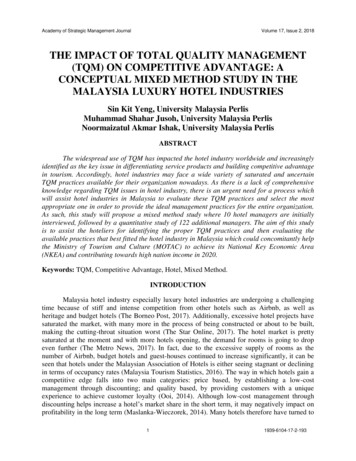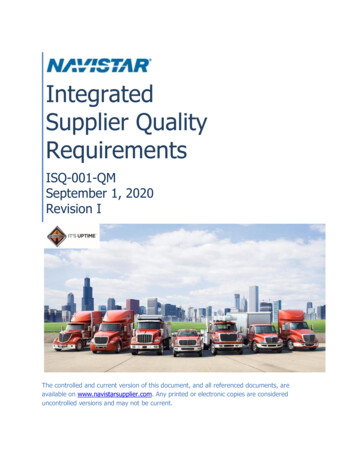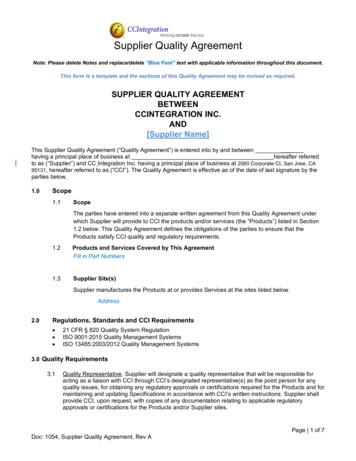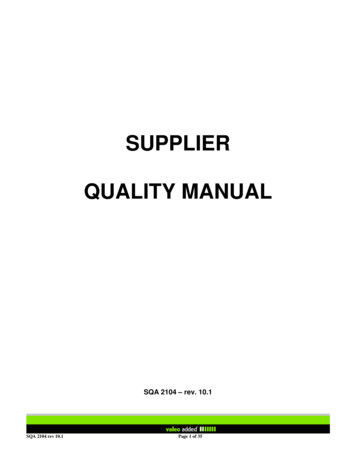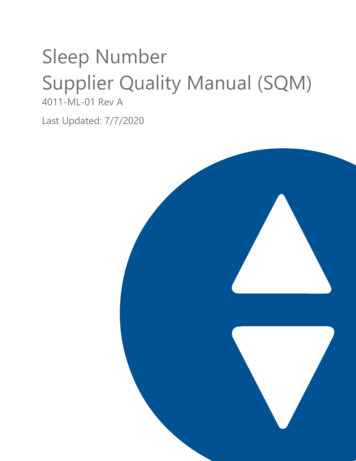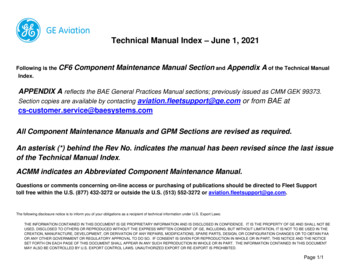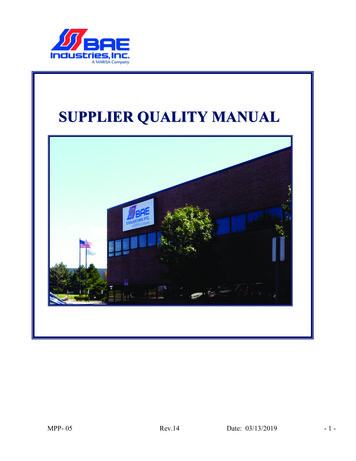
Transcription
SUPPLIER QUALITY MANUALMPP- 05Rev.14Date: 03/13/2019-1-
Table of Contents1. Introduction41.1 Preface41.2 Purpose and Scope42. Supplier Qualification42.1 Supplier Approval & Evaluation42.2 Supplier Selection52.3 Supplier Development53. Prototype/Pre-Approved Product Requirements53.1 Scope and Definition53.2 Procedure53.2.1 Quotation Requirements63.2.2 Design Requirements73.2.3 Quality Requirements83.3 Control Plan for Prototypes84. Quality Planning84.1 Specifications and Requirements84.2 Process Flow Chart94.3 Feasibility Analysis94.4 Failure Mode and Effects Analysis (FMEA)9MPP- 05Rev.14Date: 03/13/2019-2-
4.5 Control Plans104.6 Process Instructions104.7 Planning of Tooling and Equipment114.8 Gauge Measuring and Test Equipment114.9 Preliminary Process Capability114.10 Packaging Planning124.10.1 Labeling124.10.2 Shipment Documents134.10.3 Special Packing Labels134.11 Quality Assurance of Sub-Contracted Parts135. Parts Approval & Initial Samples145.1 Definitions145.2 Procedure145.2.1 Production Trial Run145.2.2 Identification of Initial Samples145.3 Productions Part Approval Process (PPAP)155.3.1 Requirements.155.3.2 Expectations of Launch Readiness165.4 Approval165.5 Tool Invoices17MPP- 05Rev.14Date: 03/13/2019-3-
5.6 Tool Tag175.6.1 Tool Tag Template176. Product & Process Quality Requirements176.1 Supplier Responsibility176.2 Process Capability Requirements186.3 Traceability196.4 Boundary Samples197. Non-Conformance & Corrective Action207.1 General207.2 Treatment of Non-Conforming Supplied Parts at BAE207.3 Reworked Parts and Problem Solving208. Supplier Performance Rating218.1 Scorecard Sections218.1.1 Quality Rating (1 to 100 pts)218.1.2 Written Complaints (0 to 15 pts)218.1.3 SOP-Disruption Score (0 to 15 pts)218.1.4 Supplier Responsiveness/Communication (0 to 10pts)228.1.5 Delivery Performance (0 to 15 pts)228.1.6 RPPM (0 to 30 pts)22MPP- 05Rev.14Date: 03/13/2019-4-
8.1.7 Competiveness (0 to 10pts)228.2 IQ Meetings238.3 New Business Hold238.4 External Production Supplier Controlled Shipping Status238.4.1 Controlled Shipping, Level 1 (CS1)238.4.2 Controlled Shipping, Level 2 (CS2)238.4.3 Controlled Shipping, Level 3 (CS3)249. Continuous Improvement249.1 General249.2 Continuous Improvement of Processes2410. Conflict Minerals Statement2511. Appendix.2611.1 Glossary2611.2 Acronyms2811.3 Issue and Revision Record3012. Supplier Signature Page31MPP- 05Rev.14Date: 03/13/2019-5-
1. Introduction:1.1. PrefaceBAE Industries, Inc. strives to meet customers and consumers highest expectations. Therefore, it isparamount that suppliers understand and meet the expectations outlined within this document.This Supplier Quality Manual is fundamental to our joint partnership and growth. It defines the qualityrequirements for development, production and verification of delivered parts and services. BAE supportsand develops teamwork with its suppliers. A clear definition of requirements and the implementation ofcommunication at all levels generate working conditions that encourage open association with ideas andproduct solutions.BAE expects that all suppliers keep to the fixed guidelines, which are part of each PURCHASE agreement.Suppliers are responsible for ensuring that their sub suppliers also fulfill these specifications.As suppliers highly influence the performance of BAE, in addition to this guideline customer requirementsare applied accordingly to them. BAE expects suppliers to develop their quality management system withthe goal of conformity to Technical Specification IATF 16949:2016. Third party registration to IATF16949:2016 or at a minimum, ISO 9001:2015 is required.MPP- 05Rev.14Date: 03/13/2019-6-
1.2. Purpose and ScopeThe Quality Guideline for suppliers applies to all internal and external suppliers of prototypes, serial partsand services for BAE. This guideline forms part of all inquiries and orders. Suppliers’ quality managementsystem should be adjusted to international quality standard IATF 16949:2016 and should be developed inaccordance with regional requirements of customers, laws and national standards. This guidelinesupports the understanding of the special requirements of BAE.2. Supplier Qualification:2.1. Supplier Approval & EvaluationBAE Purchasing maintains a list of suppliers that proved their ability to meet our expectations in the past.All materials for mass production and all services are only bought from the suppliers on the ApprovedSupplier List.Suppliers on the list are required to undergo an initial Supplier Assessment and audit prior to being addedto the Approved Supplier List. At the sole discretion of BAE, a self-assessment may be accepted until suchtime as the full assessment can be arranged. In addition, review audits may be conducted to evaluate thecurrent state of a supplier’s quality system or to verify progress toward stated goals. A typical cause for asupplier review audit may be insufficient performance. The kind of audit depends upon the deficienciesobserved.!!New suppliers’, certified according to a minimum of ISO 9001:2015, can enter the approved supplier’s listif:- The evaluation carried out by Purchasing is positive.- A BAE Supplier Assessment is successfully passed. Reference Supplier Assessment (Ref. formP06.01F08)- The BAE Supplier Approval-Maintenance Form has been signed and distributed internally and to thepotentialsupplier. Reference Supplier Approval Form (Ref. form P06.01F01)- Dependant on the amount of business being sourced, the supplier may be required to provideevidence offinancial stability.If instances require, BAE shall audit the supplier’s processes. Typical reasons may be launches of newproducts, start of production, after engineering changes, or insufficient performance of the supplier.The supplier grants BAE as well as its customers the right to visit the supplier’s to verify that sub-contractedproducts, the processes, and the services conform to specified requirements.2.2. Supplier SelectionThe selection of a supplier for a certain part or program is based on the “Approved Supplier List”. For everyproject, a document has to be prepared showing the supplier’s name; the supplier’s manufacturing facilityand the related part. Additionally, customer specific requirements are taken into consideration.MPP- 05Rev.14Date: 03/13/2019-7-
This document is signed by the purchasing, quality, engineering departments, and relevant plantpersonnel.2.3. Supplier DevelopmentBAE develops its supply base towards the IATF 16949:2016 standard. BAE is willing to support suppliersby giving the necessary information, clearly expressing our expectations and arranging meetings forexchange of knowledge and experience.To meet the requirements of BAE, the supplier’s quality management system must be based on preventionrather than detection of failures. For this reason, the use of process or design features to preventmanufacturing of non-conforming products is necessary. When potential sources of nonconforming unitsare identified by FMEA’s, capability studies and service reports, these sources shall be addressed usingmistake proofing methodology during the planning of processes, facilities, equipment and tooling as wellas during problem resolution (see sections 4 and 7).The employees are considered the most important resources of the supplier. BAE therefore requires itssuppliers to develop their personnel through extensive training and use of motivation systems toencourage their continuous improvement.3. Prototype / Pre-Approved Product Requirements:3.1. Scope and DefinitionThe requirement applies to all Supplier prototype and pre-production product.A prototype is an early sample or model built to test a concept or process. A prototype is often used aspart of the product design process to allow engineers and designers the ability to explore designalternatives, test theories and confirm performance prior to starting production of a new product.Suppliers of Prototype / Pre-Approved Product are required to meet all preliminary design, drawing andperformance specification by means of specific technical and production intent equipment where feasibleunless directed otherwise by BAE.All suppliers of Prototype / Pre-Approved Product shall provide and submit the BAE Supplier ShipmentInspection Check Sheet (Ref. document I07.04F01) with each shipment.Suppliers must also provideevidence of conformance including:·Ballooned Print or Roadmap with corresponding points·3 pc dimensional layout including all Key- Product, Critical, Significant Characteristics,·Material certification·Coating certification and testing results·Heat treat certification and testing resultsAll Prototype / Pre-Approved product shipments must be clearly identified using the Supplier Notification ofChange Label if applicable (Ref. Document I05.03F14).MPP- 05Rev.14Date: 03/13/2019-8-
All Prototype / Pre-Approved Product shipped by Supplier without Inspection Package or found with aNon-Conforming condition (without prior written authorization) will be rejected by BAE and subject toSupplier DMR including associated debits.The Evaluation and Disposition of All Prototype / Pre-Approved Product are at the discretion of theresponsible BAE Engineering and Quality representative.3.2 Procedure:3.2.1 Quotation RequirementsIf Component Prints and GD&T are not available when quoting parts, the following tolerances andrequirements are to be used to quote the parts:StampingsHoles/Slots: true position & diameter RFS or MMC 0.2 max.Profiles: profile of a surface 0.5 max.Forms: profile of a surface 1.5 max.Holes/slots: diameter /- 0.05Trim Edges 3.00!A-B-C (shear surface only)Rivets, Cold Head, Screw Machine (turned)Outer diameter: /- 0.05Shoulder Length: /- 0.05True position & diameter 0.15 max.Surface Finish – Where otherwise not called out, should be: smooth, no striations, nicks,scale, excess coating, tool marks, galling or wear marks: Per industry standard.Fineblank, Powdered Metal, (EDM)Holes/slots: true position & diameter 0.1 max.Profile of a surface 0.13 max.Hole/slots: diameter /- 0.03Trim Edges 1.0 A-B-C (shear surface only)Surface Finish – Where otherwise not called out, should be: smooth, no striations,nicks, scale, excess coating, tool marks, galling or wear marks: Per industry standard.Surface AppearanceAll metal parts are to be free of burrs and sharp edges.All plastic components are to be free of flash and short shots.DimensionsAll dimensions are to be determined using the math data and print provided.MPP- 05Rev.14Date: 03/13/2019-9-
Plastic and Rubber ComponentsPlastic and rubber components are to be free of flash, shorts, contamination, etc unlessotherwise indicated on the print.Coating (A Coat, E Coat, Phos & Oil, Zinc)Must supply evidence of coating specification and performance specification conformanceas per the drawing.Heat TreatmentHeat Treated parts must comply with AIAG CQI-09 specification as well as any othercustomer specific requirements (i.e. FORD WHTX) Reference AIAG CQI-09 manual.Special ProcessingGalvanic plating processed parts must comply with AIAG CQI-11 specification as well asany other customer specific requirements Reference AIAG CQI-11 manual.Special CoatingSpecialized coating systems parts must comply with AIAG CQI-12 specification as well asany other customer specific requirements Reference AIAG CQI-12 manual.Welding SystemsWelding processed parts must comply with AIAG CQI-15 specification as well as anyother customer specific requirements Reference AIAG CQI-15 manual.3.2.2 Design RequirementsDesign Requirements apply to all plans, processes, and procedures required for compliance with the DesignProcess.Components are to be manufactured to dimensions, tolerances and notes on the prints provided by BAE.If component prints and GD&T are not available when producing parts, the following tolerances andrequirements are to be used:StampingsHoles/Slots: true position & diameter RFS or MMC 0.2 max.Profiles: profile of a surface 0.5 max.Forms: profile of a surface 1.5 max.Holes/slots: diameter /- 0.05Trim Edges 3.00!A-B-C (shear surface only)MPP- 05Rev.14Date: 03/13/2019- 10 -
Rivets, Cold Head, Screw Machine (turned)Outer diameter: /- 0.05Shoulder Length: /- 0.05True position & diameter 0.15 max.Surface Finish – Where otherwise not called out, should be: smooth, no striations, nicks,scale, excess coating, tool marks, galling or wear marks: Per industry standard.Fineblank, Powdered Metal, (EDM)Holes/slots: true position & diameter 0.1 max.Profile of a surface 0.13 max.Hole/slots: diameter /- 0.03Trim Edges 1.0 A-B-C (shear surface only)Surface Finish – Where otherwise not called out, should be: smooth, no striations,nicks, scale, excess coating, tool marks, galling or wear marks: Per industry standard.Surface AppearanceAll metal parts are to be free of burrs and sharp edges.All plastic components are to be free of flash and short shots.DimensionsAll dimensions are to be determined using the math data and print provided.Plastic and Rubber ComponentsPlastic and rubber components are to be free of flash, shorts, contamination, etc unlessotherwise indicated on the print.Coating (A Coat, E Coat, Phos & Oil, Zinc)Must supply evidence of coating specification and performance specification conformanceas per the drawing.Heat TreatmentHeat Treated parts must comply with AIAG CQI-09 specification as well as any othercustomer specific requirements (i.e. FORD WHTX) Reference AIAG CQI-09 manual.Special ProcessingGalvanic plating processed parts must comply with AIAG CQI-11 specification as well asany other customer specific requirements Reference AIAG CQI-11 manual.Special CoatingMPP- 05Rev.14Date: 03/13/2019- 11 -
Specialized coating systems parts must comply with AIAG CQI-12 specification as well asany other customer specific requirements Reference AIAG CQI-12 manual.Welding SystemsWelding processed parts must comply with AIAG CQI-15 specification as well as anyother customer specific requirements Reference AIAG CQI-15manual3.2.3 Quality Requirements including PrototypeAll parts received at BAE will be processed through BAE’s Receiving Process and must meet all printdimensions within the allowable tolerances. Part dimensions that fall outside of these tolerances will besubject to rejection and cost recovery. Parts found to be defective will not be returned to the supplier andmay be used by BAE. BAE will be allowed to be present at all part inspection activities conducted at theprototype or supplier location. Prototype suppliers will provide the necessary documentation per BAE’sdirection for each shipment. Any nonconformity must be detailed in the documentation andcommunicated to BAE prior to shipment.3.3 Quality RequirementsControl plans for prototype material are required when deemed necessary by BAE. Please adhere to IATF16949:2016 requirements – 7.3.6.2 & 7.4.1.1 and any applicable AIAG requirements.4. Quality Planning:Advanced Quality Planning (APQP) is the basis for the prevention of potential failures. The AdvancedQuality Planning program covers the stages from development to mass production. It requires a crossfunctional team that includes all main departments such as Sales, Engineering, Production Engineering,Manufacturing, Purchasing, Tooling, Project Management, Material, Accounting and Quality Assurance.To support the BAE Quality Planning Process, supplier participation in PDT (Product Development Team)meetings are mandatory. The following chapters define the planning efforts to be taken by the supplier.A plan must be developed showing the single steps, the related completion date and the responsibilitiesfor necessary actions.Supplier Feasibility has to be proven – a determination that a process, design, procedure or plan can besuccessfully accomplished in the required time frame.Advanced Quality Planning is done in cooperation with the supplier's cross-functional team and iscontinuously checked for progress. In the case BAE does not participate however, the supplier is requiredto do this on their own and to have it approved and signed by BAE’s appropriate employee in charge. Theadvanced quality planning may result in a quality agreement defining the most important characteristicsand determining how they are to be checked and evaluated during mass production.For details, see the AIAG Reference Manuals: Advanced Product Quality Planning (APQP) and Control Plan.MPP- 05Rev.14Date: 03/13/2019- 12 -
4.1. Specifications and RequirementsBAE provides the necessary information and engineering data for all inquiries to either potential or currentsuppliers.The data includes this Quality Guideline, relevant BAE drawings, BAE specifications and technical terms ofdelivery (i.e. BAE Terms and Conditions) as well as all other applicable Government regulations andstandards which describe quality characteristics that must be adhered to. Such as “Key ProductCharacteristic”, SC and or CC’s.Any additional relevant data shall be provided by the supplier.During the Advanced Quality Planning stage, the supplier is to continuously check the engineering datawith respect to completeness, relevance and correctness. The supplier is responsible for allproduct/engineering changes being reported to all relevant departments within the organization. Thesereports must correspond with all documents issued, such as instructions for manufacturing and quality.Suppliers must adhere to any current or new customer (OEM) designated pre or post-launch requirements(i.e. GP-12).4.2. Process Flow ChartA process flow chart is the pictorial description of the process plan from receipt of goods to production ofgoods and finally to their shipment. It is supplemented by short descriptions of the individual productionsteps, lists the manufacturing equipment and the various inspection points while showing the material flow.Process flow charts are the basis for FMEAs, inspection and Control Plans.Important processes, automatic monitoring and inspection points must be identified, rated in the processFMEA regarding the existing risk and if necessary, safeguarded by appropriate methods specified in theControl Plan. Material labeling and material flow must be defined in such a manner that the processing ofwrong materials and parts is impossible. During the pre-launch stage, a current and detailed process flowchart is to be consulted in all meetings on FMEAs, Control Plans and capability evidence must also bediscussed.All core team members’ names and job title must be stated on the Process Flow Chart.4.3. Feasibility AnalysisThe feasibility analysis evaluates whether a requested part can be manufactured under mass productionconditions per the descriptions and requirements in drawings and specifications.The feasibility analysis is to be carried out by the supplier in cooperation with BAE’s departments in chargewhere appropriate. This assessment is applicable for new products, in case of product and processchanges and of major increases in volume.In particular, the indicated tolerances have to be evaluated statistically as well as the function and use ofthe component. Furthermore, a statement is required as to whether the capacity of the supplier allows forMPP- 05Rev.14Date: 03/13/2019- 13 -
the delivery of the planned number of parts and whether the scheduled deadlines can be met.Suggestions of the supplier regarding necessary changes or supplements to drawings and specificationsare expected by BAE, and will be reviewed in depth during the scheduled Design Review meetings. Theywill be implemented if they contribute to the continuous improvement of product quality, processcapability, and economical manufacturing.The following methods for feasibility analysis can be applied:·FMEAs·Process Capability Analysis·Design of Experiments (D.O.E.)4.4. Failure Mode and Effects Analysis (FMEA) :The FMEA assists in the prevention of failures through a structured analysis of the potential failure modes.FMEA’s must be used in both design and process planning. They are required for all new or changedproducts and processes. FMEA’s are “living documents” which must be continuously updated with respectto design, process and usage changes throughout the product life cycle or per customer specificrequirements.·Design FMEAs are to be prepared by the department responsible for design and engineeringactivities.·Process FMEAs identify possible process weaknesses and help work out correspondingmeasures to eliminate them. The Manufacturing Engineering Department in charge isresponsible for the preparation prior to the production of tools and facilities. Design FMEAshould be available before a process FMEA is prepared. If BAE, however, cannot make adesign FMEA available, the supplier must proceed with the preparation of a process FMEAwithout delay. (For details, Reference AIAG Manual “FMEA”)·All FMEA items with an RPN value over 100 must be addressed with actions andrecommendations stated.·All core team members’ names and job title must be stated on the FMEA.Product characteristics and process parameters identified by the FMEAs as “significant” or "critical"become essential elements of the Control Plan.The supplier shall make their process FMEA available to the BAE Supplier Quality Engineer, SupplierQuality Assurance, Product Engineer, or Advanced Product Quality Planning engineer upon request at anytime. The results of the FMEA are to be implemented prior to the initial sample inspection.4.5. Control PlansAn important phase of the process for quality planning is the development of a Control Plan. A ControlPlan is a written description of the system for controlling parts and processes. A single Control Plan mayapply to a group or family of products that are produced by the same process at the same source;however, if specifics need to be put in place, they have to be included (e.g. safety or criticalcharacteristics). Sketches, as necessary, may be attached to the Control Plan for illustration purposes. InMPP- 05Rev.14Date: 03/13/2019- 14 -
support of a Control Plan, process monitoring instructions and inspection plans should be defined andused continually.In effect, the “suppliers” Control Plan describes the actions that are required at each phase of the processincluding incoming materials, in-process, out-going, and periodic requirements to assure that all processoutputs will be in a state of control. Periodic requirements may be functional, reliability, or durability testsaccording to engineering specifications and product audits.The “suppliers” Control Plan shall be required throughout the product life cycle, i.e. starting in the Prototypephase. It will be required during the Prelaunch and Production phase. It remains a living document,reflecting the current methods of control and measurement systems used.The Control Plan contains all critical and significant characteristics identified on drawings or specifications,derived from FMEA's and known from lessons learned and suppliers' experience. Approval by BAE may berequired.The following MUST be listed on all Control Plans (See visual graphic – Figure A) :·All core team members’ names and job titles must be stated on the Control Plans·All print dimensions must be reported along with the equipment used to measure that feature·All gages used to measure parts in the process·All significant and critical characteristics·Material listed per the print specifications·Applicable customer specific requirementsFigure A: Characteristic, print dimension, method of measurement, sample size and frequency visualFor details see IATF 16949:2016 Technical Specifications and AIAG reference manuals "Advanced ProductQuality Planning and Control Plan (APQP)".4.6. Process InstructionsThe Product Quality Planning Team should ensure that understandable process instructions, jobinstructions and operator instructions provide sufficient detail for all operating personnel who have directresponsibility for the operation of the process. These instructions should be developed from the following,but not limited to, sources:·MPP- 05FMEAs·Control Plan(s)·Engineering drawings, performance specifications, material specifications, visualRev.14Date: 03/13/2019- 15 -
standards and industry standards·Process flow chart·Floor plan layout·Packaging standards·Process parameters·Supplier expertise and knowledge of the process and products·Handling requirements·Key and critical characteristics per customer specific requirementsThe process instructions for standard operating procedures are to be posted in the work place and includeall process relevant set-up parameters.4.7. Planning of Tooling and EquipmentProcess flow charts, Process Failure Mode and Effects Analysis (PFMEA), and Control Plans are to beinspected as to whether particular requirements imposed due to former problems have been sufficientlyconsidered in the design of the machines, tools, gauges and facilities. Prior to the delivery of newtools/facilities, preliminary process capability studies have to be planned and carried out.The supplier shall draw up a detailed schedule for the procurement of new or changed tools, gauges andfacilities. It has to be checked periodically to what extent this schedule has been fulfilled in order toguarantee that it corresponds with the BAE schedule. Whenever the supplier’s schedule does notcorrespond with the BAE schedule due to technical modifications, tool problems and other reasons, theBAE Purchaser in charge, the BAE Advanced Product Quality Planning Engineer responsible, and BAESupplier Quality have to be informed immediately. Proposals for necessary actions to keep the original duedate shall be submitted in writing.4.8. Gauge Measuring and Test EquipmentThe supplier is responsible for the development of suitable gauges as well as measuring and testequipment (incl. software) for satisfactory process monitoring. Furthermore, the supplier must be incompliance with the National Institute of Standards and Technology (NIST).The supplier and BAE agree on the gauging methods and the gauging equipment to be applied. In orderto ensure the production and shipment of defect free parts, all measuring and test equipment listed in theControl Plan must be certified, and capability has to be proven through the techniques described in theReference Manual “Measuring System Analysis (MSA)“.It is exclusively the supplier’s responsibility to provide standard gauging equipment. Special tests and theprocurement of the corresponding necessary gauging equipment require BAE’s approval. The gaugingmethods and equipment suggested by the supplier must be recorded in the Control Plan.Gauging equipment certifications are also required for special gauging equipment and measurementprograms using CNC-gauging-machines. The manufacturer is to develop and apply a plan, which tests thesuitability of measurement systems at sufficient intervals in order to secure the system as a whole. ThisMPP- 05Rev.14Date: 03/13/2019- 16 -
plan must be documented and continuously updated.If production tools, master parts, or similar devices are used as gauging equipment, they have to bechecked and documented in the same way as any other gauging device. Their traceability conforming toNational Institute of Standards and Technology (NIST) national resp. international reference standards forcalibration must also be ensured in this case.4.9. Preliminary Process CapabilityPreliminary process capability studies are short-term studies conducted to obtain early information on newor revised processes in view of customer requirements.The studies should be based on as many measurements as possible. At least 25 measurements of a5 piece (each piece) sample is required for all significant and critical characteristics.Initial data must be gathered in production sequence by sampling and used to develop preliminary controllimits. These limits are necessary for the evaluation of the process stability. Once the process has provedto be stable (no inexplicable values outside the control limits or other evidence of non-random behavior),preliminary process potential (Pp) and preliminary process capability (Ppk) can be determined.The indices Pp and Ppk are used to identify the results of preliminary process capability studies and todifferentiate them from ongoing process potential and capability results indicated by the indices Cp andCpk. The calculations of Pp and Ppk are based on the same formula as those of Cp and Cpk.After having evaluated the preliminary process capability for a longer period of time (e.g. twenty days ofproduction), long-term process capability studies can be performed.Processes that do not achieve the minimum Ppk requirements (see 6.2) are inadequate for production. Inthis case, cross-functional teams have to be organized immediately to work out measures for processstabilization and improvement. Until the above referenced minimum is achieved, 100% check inspection(must be approved by BAE) shall be performed and if necessary, rework (method must be approved byBAE) to be performed which must be recorded in the Control Plan and the operator instructions. When theprocess has been improved, all pre-inspections have to be repeated to confirm the improvements aretaking their affect. Accordingly, process improvements are to be documented by preliminary processcapability studies. These documents, including procedures, dates and confirmation of the 100% checkhave to be sent to BAE. The delivered products are to be labeled appropriatelySince the analysis of attributes provides only limited information, they are not suitable for preliminaryprocess capability studies. Attribute data obtained from production launches can only be used to prioritizeprocess improvements and to prepare inspection charts, but never to evaluate the preliminary processcapability.MPP- 05Rev.14Date: 03/13/2019- 17 -
4.10. Packaging PlanningThe choice of packaging could have a significant effect on product quality and
The supplier grants BAE as well as its customers the right to visit the supplier's to verify that sub -contracted products, the processes, and the services conform to specified requirements. 2.2. Supplier Selection The selection of a supplier for a certain part or program is based on the "Approved Supplier List" . For every
